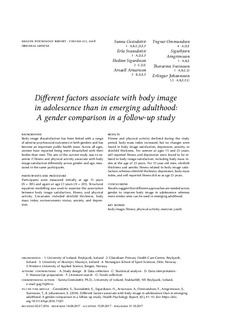| dc.description.abstract | All individuals have a certain perception of their own body, called body image. The view on body image is two dimensional: attitudinal and perceptual (Soponaru, Bojian, & Lorga, 2016). The attitudinal dimension is a subjective evaluation, positive or negative, of one´s body, based on the social desirability of physicality (Haugen, Säfvenbom, & Ommundsen, 2011; Strice & Whitenton, 2002). The perceptual dimension is the accuracy of individuals estimations of their body image (Soponaru, Bojian, & Lorga, 2016). Negative evaluation of the body, termed body image dissatisfaction, has been linked to a range of adverse psychosocial outcomes, including depression, anxiety, low self-esteem, eating disorders, and obesity (Cruz-Saez, Pascual, Salaberria, & Echeburua, 2015; Darby, Hay, Mond, Rodgers, & Owen, 2007; Dooley, Fitzgerald, & Giollabhui, 2015; Stice, 2002; Wiederman & Pryor, 2000). The emergence of body image dissatisfaction commonly follows the pubertal changes in adolescence when both genders become more aware of their bodies, and start a comparison to others (Markey, 2010). Importantly, findings from Bucchianeri, Arikian, Hannan, Eisenberg, and Neumark-Sztainer (2013) suggest that body image dissatisfaction is more than a ‘phase’ during adolescence, as it continues into emerging adulthood. Individuals of all body sizes have been found to be dissatisfied with their bodies, although higher body mass index (BMI) has been related to higher levels of body image dissatisfaction in non-clinical samples (Sarwer, Thompson, & Cash, 2005). The Western thin beauty ideal is also a risk factor for body dissatisfaction by ways of portraying women as slim, tall, and young (Levine & Chapman, 2012), whereas an extremely lean and muscular body symbolises the perfect body for men (Cafri & Thompson, 2004). The comparison to cultural values, e.g. Western beauty ideals, is in line with Vygotsky’s sociocultural theory (1978), which presents that individuals who perceive themselves and who are being perceived by others are influenced by cultural values. Body image evaluations have a vital significance for the psychological functioning and social relationships of individuals; body image is thus considered a major contributor to mental well-being (Holsen, Jones, & Birkeland, 2012). This association may, however, have different implications across gender. That is, gender differences in body image satisfaction are well-established for all age groups with the prevalence of body image dissatisfaction being higher among women than men (Lawler & Nixon, 2011; Meland, Haugland, & Breidablik, 2007). Findings among Icelandic youths (Gestsdottir et al., 2015) mirror these results, where men were found to be more satisfied with their bodies compared with women of the same age, both during adolescence and emerging adulthood. Studies have shown that body image dissatisfaction in women is more strongly correlated with clinical eating disorders targeting weight loss. Conversely, it has been associated with food supplement abuse and the use of anabolic steroids in men aiming to gain muscle mass (Mellor, Fuller-Tyszkiewicz, McCabe, & Ricciardelli, 2010; Smolak, 2004). However, little is known if different factors associate with body image satisfaction among men and women and at different time points in their lives. | nb_NO |
